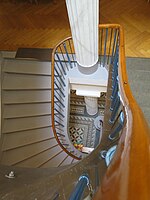Bumiller villa
The Bumiller-Villa is a bourgeois villa in Mannheim from the first half of the 19th century.
Geographical location
The villa is located in square D 7, 5. This was the outskirts of the city at the beginning of the 19th century, an area that bordered directly on the former ramparts. Today it is located in the city center and is directly adjacent to neighboring buildings on both sides.
building
The house was built around 1833 - probably by the building director Jakob Friedrich Dyckerhoff - for a private person in the classical style. At that time it was a detached villa. The house is an eaves-standing , two-story building with seven axes. On the street side, the middle three axes are highlighted as a flat risalit (on the courtyard side the risalit there comprises five axes). On the upper floor the risalit is structured by pilasters of the Ionic order . The risalit is completed by a flat gable in which there is a semicircular window - typical for the Weinbrenner School and Jakob Friedrich Dyckerhoff. Noteworthy are the hall and stairs, which - like other wall-mounted fixtures from the 19th century - are remarkably well preserved and restored. Around 1890, a winter garden made of cast iron was added to the west of the building, above the courtyard entrance, which is now a one-off in Mannheim.
The building is a cultural monument due to the Monument Protection Act of Baden-Württemberg .
Todays use
Today the building houses the psychosocial counseling and outpatient treatment center for people at risk of addiction, addicts and their relatives of Caritas .
literature
- Ferdinand Werner : Mannheim villas. Architecture and home decor in the squares and the east town . With contributions by Andreas Schenk and Tobias Möllmer (= contributions to Mannheim's architecture and building history, Volume 6). Wernersche Verlagsgesellschaft, Worms 2009, ISBN 978-3-88462-289-6
Remarks
- ↑ Construction documents no longer exist for this building, but an allocation to Dyckerhoff can be considered probable due to art-historical criteria (Werner, p. 59).
Individual evidence
- ↑ Werner, p. 59.
- ↑ Addiction counseling on the Caritas homepage .
Coordinates: 49 ° 29 ′ 23.3 " N , 8 ° 27 ′ 36" E




